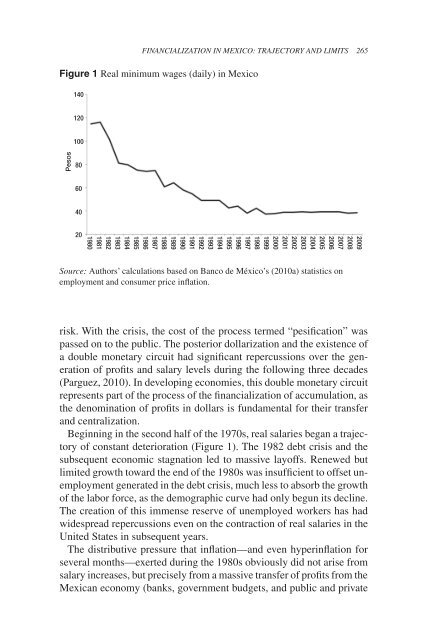Financialization in Mexico - Dr. Gregorio Vidal
Financialization in Mexico - Dr. Gregorio Vidal
Financialization in Mexico - Dr. Gregorio Vidal
You also want an ePaper? Increase the reach of your titles
YUMPU automatically turns print PDFs into web optimized ePapers that Google loves.
FINANCIALIzATION IN MEXICO: TRAJECTORY AND LIMITS 265<br />
Figure 1 Real m<strong>in</strong>imum wages (daily) <strong>in</strong> <strong>Mexico</strong><br />
Pesos<br />
140<br />
120<br />
100<br />
80<br />
60<br />
40<br />
20 2009<br />
2008<br />
2007<br />
2006<br />
2005<br />
2004<br />
2003<br />
2002<br />
2001<br />
2000<br />
1999<br />
1998<br />
1997<br />
1996<br />
1995<br />
1994<br />
1993<br />
1992<br />
1991<br />
1990<br />
1989<br />
1988<br />
1987<br />
1986<br />
1985<br />
1984<br />
1983<br />
1982<br />
1981<br />
1980<br />
Source: Authors’ calculations based on Banco de México’s (2010a) statistics on<br />
employment and consumer price <strong>in</strong>flation.<br />
risk. With the crisis, the cost of the process termed “pesification” was<br />
passed on to the public. The posterior dollarization and the existence of<br />
a double monetary circuit had significant repercussions over the generation<br />
of profits and salary levels dur<strong>in</strong>g the follow<strong>in</strong>g three decades<br />
(Parguez, 2010). In develop<strong>in</strong>g economies, this double monetary circuit<br />
represents part of the process of the f<strong>in</strong>ancialization of accumulation, as<br />
the denom<strong>in</strong>ation of profits <strong>in</strong> dollars is fundamental for their transfer<br />
and centralization.<br />
Beg<strong>in</strong>n<strong>in</strong>g <strong>in</strong> the second half of the 1970s, real salaries began a trajectory<br />
of constant deterioration (Figure 1). The 1982 debt crisis and the<br />
subsequent economic stagnation led to massive layoffs. Renewed but<br />
limited growth toward the end of the 1980s was <strong>in</strong>sufficient to offset unemployment<br />
generated <strong>in</strong> the debt crisis, much less to absorb the growth<br />
of the labor force, as the demographic curve had only begun its decl<strong>in</strong>e.<br />
The creation of this immense reserve of unemployed workers has had<br />
widespread repercussions even on the contraction of real salaries <strong>in</strong> the<br />
United States <strong>in</strong> subsequent years.<br />
The distributive pressure that <strong>in</strong>flation—and even hyper<strong>in</strong>flation for<br />
several months—exerted dur<strong>in</strong>g the 1980s obviously did not arise from<br />
salary <strong>in</strong>creases, but precisely from a massive transfer of profits from the<br />
Mexican economy (banks, government budgets, and public and private


